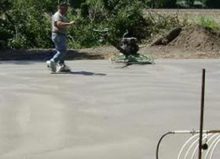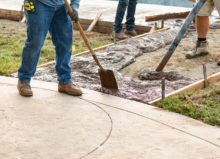Top Mistakes People Make When Installing Concrete

Concrete contractors do not get the credit they deserve. Their job is not as simple or straightforward as it may seem to a spectator. However, there are numerous calculations, tools and concrete types that must be considered before any job. Therefore, before deciding that you, with limited to no practical experience, are capable of pouring footings, pads or other concrete structures, consider some common mistakes people make.
Understanding Dimensions
It is easy to underestimate the amount of concrete you need, especially if you are not viewing the project as three-dimensional. Concrete projects are volume-based, not only surface area. Figuring out the amount of volume means understanding the geometry of the project as well as the formula for volume, which is length times width times height. However, the measurement may be more complicated when the shapes are spherical or uneven.
Underestimating Need and Use
While ordering or purchasing concrete, it is tempting to buy precisely what you need for your project. Unfortunately, jobs rarely work out that well. It is better to overestimate what you will need because it is easy to ruin a mix or fail to pour it out in time, which means that some concrete is inevitably wasted during a project.
Using the Wrong Type
Next, people fall into the trap of purchasing a generic concrete for whatever job they have, but this is a mistake. There are different types of concrete, and each type has different curing times, strengths chemical compositions. Sure, most concrete mixes include portland cement, aggregate and water, but through varying amounts and admixtures, concrete can be transformed to possess different properties for different tasks.
Poor Preparation
It is not wise to just pour concrete over a site. You need to prepare the area first. Concrete requires a level and compacted surface. Also, you should remove any roots or debris from the area as well as loose topsoil. Drainage is also necessary. However, to ensure proper drainage and reduce the risk of groundswell and failed installation, consider digging a draining trench for groundwater.
Using Improper Tools
The tools used by concrete installation services are not new-age or fancy. Contractors have been using the same tools for decades for one simple reason: they work. Also, concrete tools do not require significant setup time, which is important because time is limited when pouring concrete. While different varieties of concrete may allow for a longer timeframe, there is still a limited workable window, so it is necessary to have proper tools on hand.
Lack of Concrete Support or Knowledge
While concrete is a reliable and durable surface when fully cured, it requires help while conforming to shapes and after curing to maintain its rigidity. In a liquid state, forms must corral concrete, so it hardens into the desired shape. Also, steel rods or other bracing and support should be used to help strengthen the material and avoid future cracking.
Failing to Level or Work the Concrete
Time is of the essence when pouring concrete. For large areas, it is necessary to work the concrete as it is being poured to ensure the final project will be level and free of voids. Unfortunately, many homeowners do not understand the importance of leveling and working the concrete. True, self-leveling concrete does exist, but it is not a solution for every job, and this particular compound is meant for smaller jobs, and even those jobs may require a professional’s assistance.
Contact G&G Concrete & Construction
Commercial and residential concrete installation often requires skilled and professional labor. While big-box home improvement stores may have the necessary materials for your particular job, it does not mean the task is simple. Contact G&G Concrete & Construction at (586) 992-0964 for an assessment and an estimate of your project costs.








